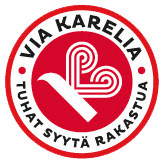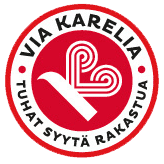Battles in Salla (30 November 1939) – 19 January – 13.3.1940
The troops of the Russian 122nd division crossed the old Finnish border in Hanhivaara, where they were delayed by Finnish border patrols. The Russian troops quickly proceeded along two lines. In north, they moved on from Salla via Savukoski to the west, and broke the Finnish defence, crossing the Kitinen river on 16 January 1940 near a location where there used to be a ferry during the Winter War. Today, there's a bridge. There, the road to Savukoski branches off main road 5, leading to Sodankylä.
The situation was dire, because once having crossed the river, the Russians had an open route following the Kitinen river all the way to Sodankylä and from there, toward Petsamo, and south to Kemijärvi following the Kemijoki river.
Since 11 December 1939, a special "Lapland Group" was put in charge of defending Lapland. Its command was appointed to Major General K.M.Wallenius on 13 December 1939 . He launched a counteroffensive at Pelkosenniemi on 16 December 1939. In the Pelkosenniemi battle on 17-19 December 1939, Wallenius was the first to use a tactic that later became known as the "motti" tactic. Three battalions encircled and split up the Soviet infantry regiment. Those of the Russian troops that remained alive, fled in disarray, leaving behind their heavy war equipment.
Another group of Russians had pushed the Finnish troops, following the line of the Salla – Kemijärvi road, first from Salla's old church to Paikanselkä, west of the current church village of Salla, and then to Joutsijärvi, near Kemijärvi on 14 January 1940. After the victory in Pelkosenniemi, Finns focused their troops to this direction. The Russians retreated to Märkäjärvi (current Salla church village) on 11-16 January 1940. The Finns grouped at Paikanselkä. That is where the front line remained for the remainder of the war.
The Swedish volunteers assumed responsibility for the front line in Salla on 27 February 1940. Swedish General Ernst Linder was appointed as the commander of the Lapland Group.
War memorials in Salla
There are five memorials at a memorial site in Paikanselkä, near Salla church village, about 4 km toward Kemijärvi.
Paikanselkä
Memorial of the battles of Salla and the ending of the Winter War is by the Salla-Kemijärvi road (82), on the north side, about 4 km from Salla. There's a parking area nearby. The area has information boards about the battles in many languages, and a text that reads: ”At the end of the Winter War on 13 March 1940 at 11:00 the front line ran here in Salla”.
Memorial stone for Swedish volunteers
On the other side of the road at the same location, there's a memorial stone for the Swedish volunteers.
In the final stages of the war, Paikanselkä was mainly manned by the Swedish volunteers.
The stone reads in Swedish: ”For the memory of our friends, who lost their lives for the freedom and honour of the North in 1940”. The stone was erected in 1952 by the first group of Swedish volunteers. The stone has the names of the six fallen persons of the group. The first one is lieutenant colonel Magnus Dyrssen, perished on 1 March 1940, who was one of the key persons in establishing the group of volunteers. He was the leader of the 1st group or volunteers.
Memorial of Magnus Dyrssen
From the memorial of Swedish volunteers, a marked path leads to the spot where Dyrssen died, where there's a memorial stone. The distance is about 200 metres. The stone was erected in 1949. The text says: ”Here fell Magnus Dyrssen on 1 March 1940 for freedom of the North and for the honour of Sweden”. In the vicinity, there are derelict dugouts and battle stations of the Winter War.
The new memorial stone for the Swedes
A new memorial for the Swedish volunteers was unveiled near the original on 9 June 1990. It has the names of the 32 Swedes who fell in the Winter War. The association of Swedish volunteer groups donated a Bofors 37mm anti-tank gun to Paikanselkä in 1995. The same kind of gun was used for destroying a Soviet tank in Paikanselkä.
Memorial of the Knights of the Mannerheim Cross
A memorial for the Knights of the Mannerheim Cross was unveiled in Paikanselkä in 1992. One of them had been living in Salla; captain Olli Remes.
Other memorials in Salla
Memorial for fallen Soviet soldiers
In Salla church village, Tapulintie road in Karhumäki, there's a memorial for fallen Soviet soldiers, designed by Osmo Rautiainen. It reads: ”Soldiers of the Red Army. They fell for better future of the mankind”. The memorial was erected in 1946. It is in a residential area by the road to Kuusamo. Driving directions: Drive up the hill at the Library.
”Sotkan kellari”
Heikki Sotkajärvi moved his family to ”Sotka” from Märkäjärvi village (the current Salla church village) in 1910. He founded a crown croft for a staging post between Hautajärvi and Märkäjärvi. The small cellar is the only building in Sotka that survived the Winter War. It was restored in 1996. You can find the spot on Via Karelia, about 12km from Salla to Hautajärvi.
During the Winter War, four Finnish soldiers were using the cellar for keeping warm, when they were surprised by a Russian patrol. The Finns locked themselves in, while the Russians used hand grenades to destroy them. The Finns blocked the air shaft with their back packs, and the grenades couldn't get in to harm them, exploding on the roof.



